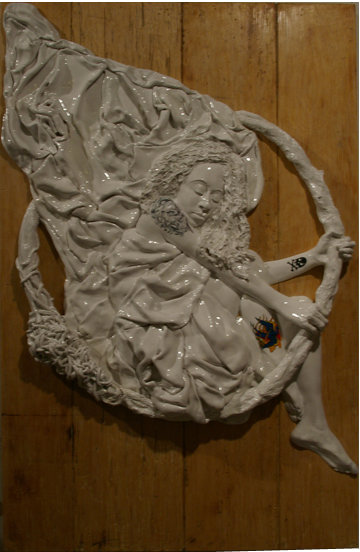3/9/2008
Jeph Gurecka
31Grand, New York
Shiny Bright Souvenir

31GRAND is pleased to present SHINY BRIGHT SOUVENIR. Roughly based on
Thomas Cole's Voyage of Life painting series and 18th century Romanticism,
SHINY BRIGHT SOUVENIR is a nautical passageway from the past, both in an art
historical context and from feelings and expectations associated with the
romantic period. Cole¹s Voyage of Life (1840) series of paintings is the
allegorical story of a voyager who travels in a boat on the river of life
with an angel. This combination of the sublime with religious,
philosophical, and contemporary socio-political themes is prevalent in
Gurecka¹s SHINY BRIGHT SOUVENIR.
Brought home by the traveler, souvenirs and tchotchkes function as physical
manifestations of the memories associated with the journey. Likewise,
history itself is a souvenir of the past that is glamorized and glossed over
by indulgent radiance in the present. Gurecka finds humor and absurdity in
how easily memory devolves into nostalgia, which in turn degrades into
consumerism. For Gurecka, the souvenir is a hopeless projection and a
representation of fear; in this, his vision accords with Nietzsche¹s
description of nostalgia as the longing for the past, the contempt for the
present, and the fear of the future.
The Voyage of the Crystal Symphony shows the Crystal Symphony cruise ship
retreating from the constellation Aquarius at its rear and entering the eye
of a fantastic, sublime storm. Immanuel Kant talks about the sublime and
how the safest way to the sublime is through the idea of the subsidiary
venues, which for the contemporary traveler translates into our present day
cruise lines, amusement parks, casinos, and video games.
In the wall relief, Sleeper, a siren floats along on a similar journey.
Romanticism was loaded with mythic stories of the mystic relationships
between men, women, and water. In their desperate loneliness, seamen
believed that lighthouse s were kept by sirens, who lived on rocky islands
where they lured ships to their destruction. Similarly, the goddess of
beauty herself, Venus, was born of vengeance: the severed genitals of
Uranus, who was castrated by his son, Cronus, fell into the sea and
fertilized the water from which Venus arose. As an amalgamation of beauty
and destructiveness, perhaps the danger of Gurecka's siren is her somnolent,
latent wrath.
In the illuminated sculpture, My Fathers House, biblical, mythological and
personal attributes contrasted with the artist¹s homage to his birth father
and their struggles for individuality. The softly illuminated cast Lincoln
log house atop a rough, sinewy, trunk-like pedestal is both welcoming and
subtly menacing. Here Gurecka melds the iconographically powerful image of
the lighthouse‹with its references to solitude, the sea, sirens, and the
Christian symbol of divine guidance‹with the struggle for autonomy.
Personal memory flattens into a collective and anonymous past: consumer
culture takes advantage of a lack of awareness through mythologizing and
fetishizing experience. In Gurecka¹s cast sculpture of an SUV tire sinking
into the gallery floor (We Will Never), this type of patriotic consumerism
creates a falsely empathetic slogan.
In past work, Gurecka relied on the organic material and its relevance to
the idea, a heterogeneous entity where the material was actually the host to
the idea. In much the same way, Gurecka now deals with a very organic
material in our natural world: plastic. Arguably, what once was
nature/natural persists in the contemporary world, equally present in the
dyad of city and country or in the contrived in-between; the simulacrum of
suburbia is as manifestly real as other experiences.
Opening reception: Thursday Sept. 4, 7-9pm
31Grand
143 Ludlow Street - New York
Free admission



